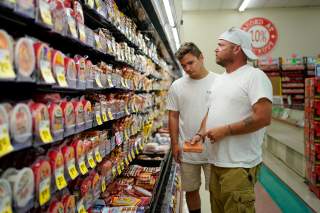Why Healthy Foods Won't Fix Your Health Problems
Eliminating food deserts won’t help poorer Americans eat healthier.
In the U.S., rich people tend to eat a lot healthier than poor people.
Because poor diets cause obesity, Type II diabetes and other diseases, this nutritional inequality contributes to unequal health outcomes. The richest Americans can expect to live 10-15 years longer than the poorest.
Many think that a key cause of nutritional inequality is food deserts – or neighborhoods without supermarkets, mostly in low-income areas. The narrative is that folks who live in food deserts are forced to shop at local convenience stores, where it’s hard to find healthy groceries. If we could just get a supermarket to open in those neighborhoods, the thinking goes, then people would be able to eat healthy.
The data tell a strikingly different story.
Negligible change
We recently studied the impact of opening supermarkets in food deserts in research conducted with fellow economists Rebecca Diamond, Jessie Handbury and Ilya Rahkovsky.
From 2004 to 2016, over 1,000 supermarkets opened in neighborhoods around the country that previously had been food deserts. We analyzed the grocery purchases of a sample of 10,000 households living in those neighborhoods.
Did they start to buy healthier food after the supermarket opened nearby?
Although many people began shopping at the new local supermarket after it opened, they generally didn’t buy healthier food. We can statistically conclude that the effect on healthy eating from opening new supermarkets was negligible at best. We calculated that local access to supermarkets explains no more than about 1.5% of the difference in healthy eating between low- and high-income households.
How could this be?
Why food deserts aren’t the problem
The food desert narrative suggests the lack of supply of healthy foods is what causes reduced demand for them.
But in the modern economy, stores have become amazingly good at selling us exactly the kinds of things we want to buy. Our research suggests the opposite narrative: Lower demand for healthy food is what causes the lack of supply.
Furthermore, local neighborhood conditions don’t matter much, since we regularly venture outside our neighborhoods. We calculate that the average American travels 5.2 miles to shop. Low-income households aren’t that different: They travel 4.8 miles.
Given that we’re willing to travel that far, we tend to shop in supermarkets even if there isn’t one down the street. We found that even people who live in ZIP codes without a supermarket still buy 85% of their groceries from supermarkets.
Tax sugar, subsidize produce
In other words, people don’t suddenly go from shopping at an unhealthy convenience store to shopping at the new, healthy supermarket. In reality, people go from shopping at a faraway supermarket to shopping at a new supermarket that offers the same types of groceries.
To be clear, new grocery stores do provide many benefits. In many neighborhoods, new retail can bring jobs, a place to see neighbors and a sense of revitalization. People who live nearby get more options and don’t have to travel as far to shop.
But the data show that healthier eating is not one of those benefits.
Instead, we would recommend tweaking prices as a better approach to encouraging healthier habits. Taxes on sugary drinks can discourage their consumption, while food-stamp programs could be modified to make fruits and vegetables cheaper.
And, given that we develop long-term eating habits as children, parents and schools can encourage kids to eat healthier.
Health inequality is one of our society’s most important problems. We hope that this research can direct efforts toward ideas that can materially improve health – and away from ideas that do not.
![]()
Hunt Allcott, Associate Professor of Economics, New York University; Jean-Pierre Dubé, Sigmund E. Edelstone Professor of Marketing, University of Chicago, and Molly Schnell, Assistant Professor of Economics, Northwestern University
This article is republished from The Conversation under a Creative Commons license. Read the original article.
Image: Reuters

